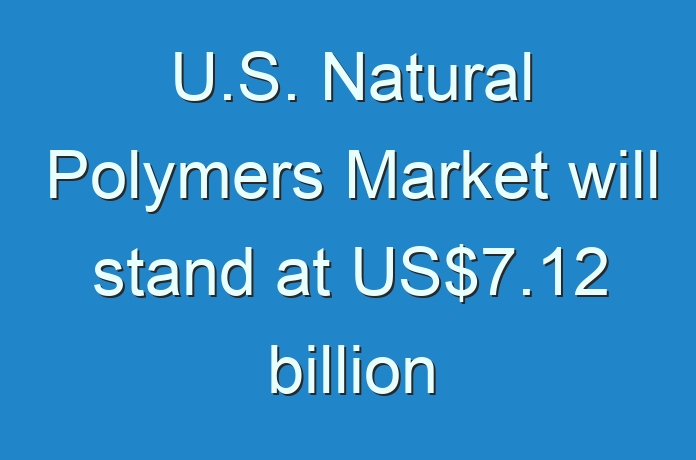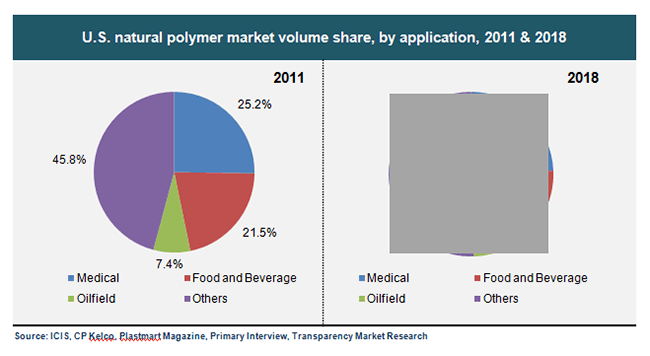
In its latest study focused on the natural polymers market in the United States, Transparency Market Research estimates that in 2012, the demand for natural polymers was US$4.95 billion, and will grow at a CAGR of 6.2% from 2012 to 2018, by which year it will stand at US$7.12 billion. The report is titled “Natural Polymers – U.S. Industry Analysis, Size, Share, Growth, Trends and Forecast, 2012 – 2018.”
Browse the full Natural Polymers Market (Cellulose Ethers, Starch and Fermentation Products, Protein Based Polymers and Others) for Medical, Food and Beverage and Oilfield Applications – U.S. Industry Analysis, Size, Share, Growth, Trends and Forecast, 2012 – 2018 report at https://www.transparencymarketresearch.com/natural-polymers-market.html
The report finds that natural polymers are finding widespread applications in the shipment of non-durable goods, pharmaceuticals, as well as food and beverages. As the shipments of all of these products continue to show an upward graph, the demand for natural polymers in the United States is slated to exhibit an increase too. The study focuses on key applications such as food and beverages, medical, oilfield, as well as other applications such as cosmetics, toiletries and packaging classified under a segment called ‘others’.
Request PDF Brochure –
https://www.transparencymarketresearch.com/sample/sample.php?flag=B&rep_id=1257
An extensive analysis of all of these segments reveals that in U.S. natural polymers market, medical applications trumped all others, with a 25.6% share of the total revenue generated as of 2012. Also, the most extensively consumed type of natural polymer in the U.S. natural polymers market was cellulose ether; it constituted 36.5% of all recorded consumption volumes as of 2012.
 The demand for
The demand for
pharmaceuticals is increasing, and as a result, this application area will also witness higher growth. This growth in pharma applications will have a cascading effect wherein the demand for fermentation products and starch will also spike. Cellulose ethers-derived from the photosynthesis of wood pulp, cotton and certain other plant types-are used in a variety of markets like medical, food and beverages, and oilfield operations.
REQUEST FOR COVID19 IMPACT ANALYSIS –
https://www.transparencymarketresearch.com/sample/sample.php?flag=covid19&rep_id=1257
Some of the most commonly used types of cellulose ethers include: Methyl Cellulose (MC), Carboxymethyl Cellulose (CMC), Hydroxyethyl Cellulose (HEC), and Microcrystalline Cellulose (MCC). According to the estimates of this market study, by 2018, the demand for starch and fermentation products will likely rise to 479.3 kilotons, exhibiting a CAGR of 12% between 2012 and 2018.
Explore Transparency Market Research’s award-winning coverage of the global (Chemicals and Materials) Industry
The study also discusses the important end-user industries within the U.S. natural polymers market. These end-user industries include: Adhesives and sealants, toiletries, packaging, leather tanning, construction, paint and inks, and textiles. One of the most important segments that generates considerable revenue for the U.S. natural polymers market is that of packaging. A number of natural polymer-based materials are required for packaging applications. In fact, several players in the U.S. natural polymers market are focused mainly on the packaging segment and conduct extensive research to come up with new and more innovative methods for packaging.
This report also closely profiles the leading players in the U.S. natural polymers market. Some of these names include: Ashland Inc., Economy Polymers & Chemicals, Dow Chemical Company, JM Huber, Archer-Daniels-Midland, Novamont, Plantic Technologies, FMC Corporation, Cargill Inc., Danisco, Cereplast, CP Kelco, Allergan, Croda International plc, BASF SE, and AkzoNobel NV.





